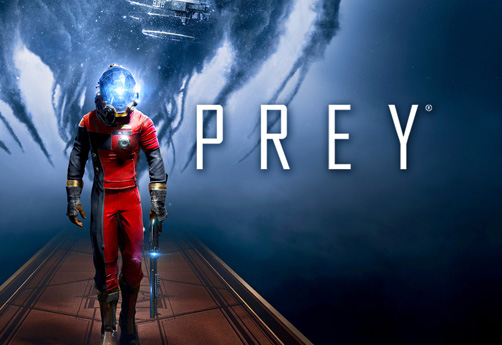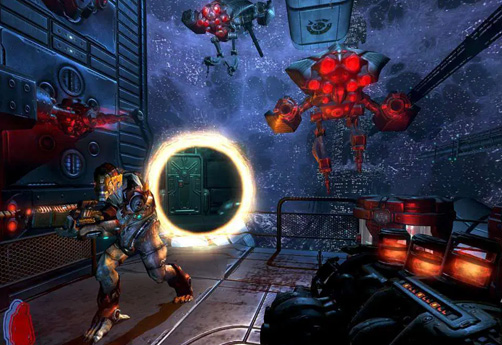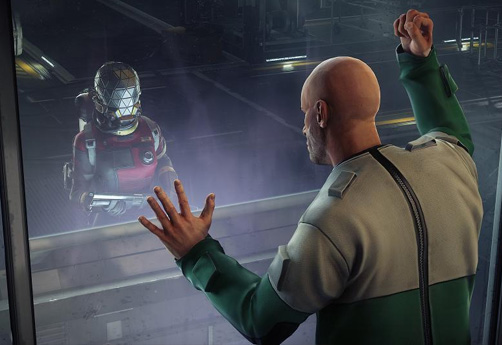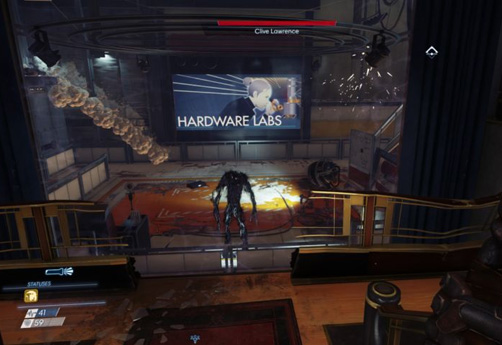Prey Game Review

Talos I's structure and design is thoughtfully crafted
Combat becomes satisfying and rewarding
Space sections are a nice change of pace
Story feels thin
Lack of memorable characters
Early game is a grind
Obnoxious audio design
Quests are mostly uninspired
As a tribute to System Shock, she is competent and at times even entertaining. However, Prey is unremarkable and stagnant compared to modern immersive sims like Dishonored.
About The Game
The Prey gameplay setting is in the year 2032, Prey casts the player as Morgan Yu, a scientist that finds herself–or himself–trapped on Talos I, a space station overrun by a race of highly intelligent aliens called the Typhon. Morgan Yu was involved in the development of Neuromods, a technology derived from the Typhon that allows humans to augment their abilities. She was the first test subject for them, hot-swapping Neuromods in and out of her brain with reckless abandon. During the removal procedure, the memory of a user is rolled back to its pre-installation state, and since the game begins shortly after some mods are ripped out of her brain, Morgan–and by proxy, the player–starts as an amnesiac.
Prey’s game-opening is its most impressive part, largely due to its own “Would you kindly” moment, and the promise of what it could mean. At the end of Irrational’s BioShock, the revelation surrounding this phrase re-contextualizes the events of the entire game to deliver a commentary on player agency. Prey subverts this with an early game twist that lays the groundwork for players to scrutinize their agency at the moment, question the motivations of characters as they appear, and re-evaluate the impact they’re having throughout. This is your chance to tell a twisted, paranoid story that will make you rethink your character. Unfortunately, this opportunity is often missed. Prey quickly unraveled this storytelling thread in favor of environmental storytelling that refocused the focus back on Talos I itself. Combining Art Deco style with utilitarian design, the Talos I is very impressive at first glance. It has crimson furniture and the shiny gold frames of a baroque hotel, but this abstracts the darkness of the space seen through the huge glass windows. With glowing blue computer screens and neon décor of other futuristic technologies, Talos I has a distinct visual identity, but it gets boring.
Video game worlds are often developed on the same principles as amusement parks, with zones supporting unique themes for variety. Talos I, nevertheless, maintains a consistent aesthetic throughout its various areas, breaking the uniformity of its visual design only for the Arboretum, where lush vegetation, towering trees, and snaking vines are entangled with cold space station architecture. The place is composed of typical living quarters, office areas, and an abundance of science labs in various states of disarray. The absence of variety makes sense–it’s an installation designed to house people that do science, not a funfair. Regardless, the lack of variety provides little incentive to stop and admire your surroundings beyond the initial few hours.
Fine immersive sims–like BioShock and Dishonored 2–weave stories into their environments. In Prey, however, those stories are limited to either “people were here, Typhon appeared, killed everyone, knocked over furniture, and blew holes in things” or “Typhon was being experimented on here, they got out, knocked over furniture, and destroyed all the expensive science stuff.” A space station destroyed by a disastrous event and the hubris of its leaders is evocative in itself, but this is just the outline of events, and without more color Prey’s world reveals itself to be vapid and lacking in depth.
Smaller tales involving the people stationed on Talos I can be found by reading emails at computer terminals, and although they provide a little more to latch onto, by and large, it’s all similarly forgettable. Emails are mostly the kind of thing you’d expect a bunch of coworkers to be contacting each other about: complaining about colleagues, reminding each other about best practices in the workplace, or explaining why that door you need to get through is locked.
Concealed amongst all the emails and loose papers scattered around environments is the occasional meaningful exchange–like a group arranging a Dungeons & Dragons game complete with character build sheets, a multi-part treasure hunt, details of shifts in Morgan’s personality during the Neuromod testing, or theories on the strange abilities the Typhon exhibit. Again, these are useful in creating a sense that Talos I was a real, functioning place where people worked and lived together, but the abundance of mundane notes makes reading them a chore, and overall they feel like filler for an overarching narrative that’s stretched thin.




Game Features
The vital part of Prey’s story is presenting conflicting evidence about Morgan’s personality before the memory loss, specifically her intent for Talos I and her contingency for a Typhon outbreak. The Prey game wants you to define Morgan by completing select side-quests that require moral decisions. Nonetheless, it only fits a handful of these moments and they come in the form of uninspired missions for characters who seem like distractions from the main narrative instead of pivotal figures in the outcome of the story. Prey makes an honest effort to increase the reputation of these people, but it happens late in the game, and when all is said and done, the characters still feel disposable. In Talos I, Prey has a fickle restraint, but that fades when that philosophy extends to her personality.
Who can blame you for wanting to ignore the person asking you to do your best to get your artifact back? Or that woman who has to expend her precious resources fighting her Typhon to heal her? However, it turns out that these secondary tasks are very important to the finale. And when the game unexpectedly placed everything and tied everything together, the revelation didn’t feel like it deserved. Prey occasionally has exciting missions, such as tracking down an escaped criminal, but these missions are rare and often end very disappointingly.
Prey’s gameplay is better, but it’s uneven, and the systems sometimes don’t play together. Limited access to weapons and special abilities makes much of the early game feel boring. Typhon is plentiful and absorbs damage, so you drop ammo while draining health and then struggle to survive as you run out of resources. It’s like the worst part of survival horror. It’s a punitive battle of attrition, but there’s no cycle to relax and enjoy. This becomes apparent when you consider that Mimics, the most common type of Typhon enemy in the early stages, tend to spawn in blind spots and startle players. This part of the game is simultaneously thrilling and infuriating. The Mimics are small, highly mobile creatures that can shapeshift into innocuous objects around them. This implies that you can stroll into a room and be completely unaware that a Mimic waits just a few feet away, disguised as a cup or a trash can. While this was effective in creating tension, it also detracted from exploration;
There are methods to uncover a Mimic before it strikes, most notably by scanning environments using the Psychoscope, but having to put it on every time you enter a room becomes tiresome. The scanner is agreeably fitted for rooting out a Mimic once it has revealed itself and skittered away to hide again.
Mimics are joined by Phantoms, which are the result of Typhon reanimating dead human bodies. These wraith-like beasts patrol Talos I and, given their ample health pool, are difficult to bring down early on. They`re not particularly impressive to fight since they just close the gap and physically attack you, and they eat up a whole load of resources to successfully vanquish. This opponent type becomes more engaging as elemental variants are introduced, as they can limit the weapons you use, split into multiple attackers, or set the environment on fire.
Again, early on in this game it feels like a pain for exploring the more interesting wrinkles of combat, but over time, turrets become less of an issue as they can be hacked or easily destroyed. In the later stages, Prey’s combat looks varied and strategic. The deeper you dig into Talos I, the more you will find refiners and manufacturers. You can use it to disassemble and reassemble useful items, from weapon and Neuromod upgrades to turrets and medical kits. This greatly reduced the resource pressure and gave me the ability to approach combat and exploration the way I wanted to. Some areas are designed to allow a degree of freedom of approach. Typically, the possibilities are obvious: if you don’t have a keycard, you can hack the lock, look for a vent to crawl through or use brawn to move an obstruction. ‘
One of the more clever ways to overcome an obstacle is to grab a small object like a cup, use Mimic Matter to turn into it, and slip through small openings. Of course, your approach is dictated by the upgrades you’ve unlocked, so if you’ve designed Morgan with specific ability paths instead of diversifying his ability upgrades, you’ll be able to regularly approach these puzzles the same way. These puzzles aren’t difficult, but they provide information about the Talos I plan. The Creation of Talos I. GLOO Cannon is particularly good at showing how Prey’s environments can stack up. When shot at a wall, it hardens, allowing Morgan to use it as temporary scaffolding. This provides an opportunity to circumvent the obvious path to a more varied approach by highlighting the thoughtful level of design. Where Talos shines, however, is that once you leave the station entirely, you can enter its space and enjoy it from the outside. This can be done by opening specific doors in each area. It’s very interesting to see how all the parts fit together and find alternate entry points for different parts of the station. Traveling through Talos brought the scale of the space station to mind. Meanwhile, the mix of cosmic noise and Typhon’s distant trills gave me a strange, carefree feeling. Prey’s space exploration left an unexpected impression.
His elemental powers destroyed the elevator and prevented me from using it. Prey also suffers from long loading times when moving between areas. This is especially noteworthy as you have to travel back and forth between different locations while completing side quests. Meanwhile, the soundtrack is drowned out by the sounds of a warehouse full of fax machines and modems running simultaneously. Combined with multiple characters speaking dialogue in unison, it results in pure, insane auditory chaos. Prey’s technical issues also exist on Xbox One.
This version has long loading times when moving between regions and a slight delay when entering a new room in the current region. Combat is sluggish and imprecise, although this has been fixed in the PC version thanks to the mouse control option. The PC also has the shortest load times, lasting around 10-15 seconds between many opening areas, compared to just over a minute for both console versions. If you have a chance, try playing the PC version as well. Prey is a game with uneven pacing and uninteresting characters. It starts with a sharp, suggestive premise, but doesn’t go all the way when it calls for a revelation it doesn’t deserve. Its gameplay goes off the grid and eventually turns into something slightly familiar but worthwhile. As a tribute to System Shock, she is competent and at times even entertaining. However, Prey is unremarkable and stagnant compared to modern immersive sims like Dishonored.
Game Trailer
In order to have more insight into this game, you can watch this video from the following link:
You can visit the website of Prey Game Review by Mr. Frog to understand the game more.


























































































































































